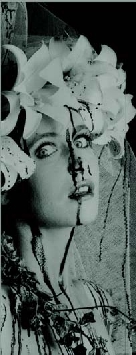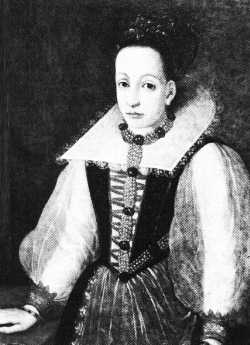Shyla's History of Erzsébet
[Note from Dennis: This page was written several years ago and contributed by Shyla, then an art student. It continues to be included here only for site completeness. It has factual errors, and should not be used for reference.]
1560: Elizabeth Bathory is born into one of the oldest and wealthiest families in Transylvania. Her family had many powerful relatives -- a cardinal, princes, and a cousin who was prime minister of Hungary are among these relatives. The most famous relative was Istvan (ISHT-vahn) Bathory (1533-86). Istvan was prince of Transylvania and king of poland from 1575-86. It has been said that At around the age of 4 or 5, Elizabeth had violent seizures. These may have been caused by epilepsy or another neurological disorder and may have something to do with her "psychotic" behavior later in life.
1575: Age 15, Elizabeth married Count Ferenc (pronounced FAIR-entz) Nadasdy (NAW-dawzhd with silent y). The Count was 26 years of age. The count took Elizabeth's surname so that she could keep her name. They lived together in Castle Cséjthe (which in hungarian is pronounced CHAY-tuh). In Slovak this Castle is named Cachtice (pronounced CHAKH-teet-suh). [To this day there is rivalry between the Hungarians and the Slovak's and you will get a blank expression if you refer to the "wrong" name.] The count spent a great deal of time away from home fighting in wars and for this he was nicknamed "The Black Hero of Hungary". While her husband was away Elizabeth's manservant Thorko introduced her to the occult. For a brief time Elizabeth eloped with a "dark stranger". Upon her return to Castle Cachtice the count did forgive her for her leaving. Back at the castle, Elizabeth couldn't tolerate her domineering mother-in-law. With the help of her old nurse Ilona Joo, she began to torture the servant girls. Her other accomplices included the major-domo János Ujvary (pronounced YAH-nosh OOEE-vahr-yuh), Thorko, a forest witch named Darvula and a witch Dorottya Szentes. The first ten years of their marriage, Elizabeth bore no children because she and Ferenc shared so little time together as he pursued his "career." Then around 1585, Elizabeth bore a girl whom she named Anna, and over the following nine years gave birth to two more girls, Ursula and Katherina, and in 1598 bore her first and only son, Paul. Judging from letters she wrote to relatives, she was a good wife and protective mother, which was not surprising since nobles usually treated immediate family very differently from the lower servants and peasant classes.
1600: At age 51, Count Ferenc died in battle and thus began Elizabeth's period of atrocities. First, she sent her hated mother-in-law away from the Castle. By this time it is thought that she had dabbled into some forms of sorcery, attending rituals that included the sacrificing of horses and other animals. Elizabeth, now 40 years old, grew increasingly vain and she feared the thought of aging as she may lose her beauty. One day a servant girl accidentially pulled her hair while combing it. Elizabeth slapped the girl's hand so hard she drew blood. The girls blood fell into ELizabeth's hand and she immediately thought that her skin took on the freshness of her young maid. She believed that she had found the secret of eternal youth. Elizabeth had her major-domo and Thorko strip the maid and then cut her and drain her blood into a huge vat. Elizabeth bathed in it to beautify her entire body.
1600 - 1610: Elizabeth's henchmen continued to provided Elizabeth with new girls for the blood-draining ritual and her blood baths. Elizabeth went out of her way to see to it that the dead girls were given proper Christian burials by the local Protestant pastor, at least initially. As the body count rose, the pastor refused to perform his duties in this respect, because there were too many girls coming to him from Elizabeth
who had died of "unknown and mysterious causes." She then threatened him in order to keep him from spreading the news of her "hobby" and continued to have the bodies buried secretly. Near the end, many bodies were disposed of in haphazard and dangerously conspicuous locations (like nearby fields, wheat silos, the stream running behind the castle, the kitchen vegetable garden, etc.). But one of her intended victims escaped and told the authorities about what was happening at Castle Cachtice. King Mátyás (MAHT-yash) of Hungary ordered Elizabeth's own cousin, Count György (pronounced DYERD-yuh) Thurzo, governor of the province to raid the castle. On December 30, 1610 they raided the castle and they were horrified by the terrible sights. One dead girl in the main room, drained of blood and another alive whose body had been pierced with holes. In the dungeon they discoverd several living girls, some of whose bodies had been pierced several times. Below the castle, they exhumed the bodies of some 50 girls.
1611: A trial was held at Bitcse. Elizabeth, who refused to plead either guilty or innocent, and never appeared in the trial.. At this trial Johannes Ujvary, major-domo, testified that about 37 unmarried girls has been killed, six of whom he had personally recruited to work at the castle. The trial revealed that most of the girls were tortured for weeks or even months. They were cut with scissors, pricked with pins, even prodded with burning irons onto short spikes in a cage hung from the ceiling to provide Bathory with a "blood shower". Sometimes the two witches tortured these girls, or the Countess did it herself. Elizabeth's old nurse testified that about 40 girls had been tortured and killed. In fact, Elizabeth killed 612 women -- and in her diary, she documented their deaths. A complete transcript of the trial was made at the time and it survices today in Hungary. Of the people involved in these killings, all but Countess Bathory and the two witches were beheaded and cremated. Due to her nobility, Elizabeth was not allowed by law to be executed. The tow accomplices had their fingers torn out and were burned alive. The court never convicted Countess Elizabeth of any crime, however she was put under house arrest. She was sentenced to life imprisonment in her torture chamber and stonemasons were brought to wall up the windows and doors of the with the Countess inside. They left a small hole through which food could be passed. King Mátyás
II demanded the death penalty for Elizabeth but because of her cousin, the prime minister, he agreed to an indefinitely delayed sentence, which really meant solitary confinement for life.
1614: On July 31 Elizabeth (age 54) dictated her last will and testament to two cathedral priests from the Esztergom bishopric. She wished that what remained of her family holdings be divided up equally among her children, her son Paul and his descendants were the basic inheritors though. Late in August of the year 1614 one of the countess's jailers wanted to get a good look at her, since she was still reputedly one of the most beautiful women in Hungary. Peeking through the small aperture in her walled-up cell, he saw her lying face down on the floor. Countess Elizabeth Bathory was dead. Her body was intended to be buried in the church in the town of Cachtice, but the grumbling of local inhabitants found abhorrent the idea of having the "infamous Lady" placed in their town, on hallowed ground no less! Considering this, and the fact that she was "one of the last of the descendants of the Ecsed line of the Bathory family", her body was placed to the northeastern Hungarian town of Ecsed, the original Bathory family seat.
More Information:
- All records of Elizabeth were sealed for more than a century, and her name was forbidden to be spoken in Hungarian society.
- Unlike most females of the time, Elizabeth was well educated and her intelligence surpassed even some of the men of her time. Elizabeth was exceptional, becoming "fluent in Hungarian, Latin, and German... when most Hungarian nobles could not even spell or write...Even the ruling prince of Transylvania at the time was barely literate"(20). Some modern scholars and contemporaries of hers postulated that she may
have been insane, thus accounting for her seemingly inconceivable atrocities, but even a brief glance into her past reveals a person fully in control of her faculties.
- Dracula, created by the Irish author Bram Stoker, was based, albeit loosely, on the Romanian Prince, Vlad Dracula, the Impaler. Raymond T. McNally, who has written four books on the figure of Dracula in history, literature, and vampirism, in his fifth book, "Dracula was a Woman," presents insights into the fact that Stoker's Count Dracula was also strongly influenced by the legends of Elizabeth Bathory of Hungary. Why, for example, make a Romanian Prince into a Hungarian Count? Why, if there are no accounts of Vlad Dracula drinking human blood, does blood drinking consume the Dracula of Stoker's novel, who, contrary to established vampire myth, seems to appear younger after doing so? The answers, of course, lie in examining the story of Countess Elizabeth Bathory.
- It was largely Slovak servants whom Erzsebet killed, so the name "Csejthe" is only spoken in derision, and she is still called "The Hungarian Whore" in the area.



